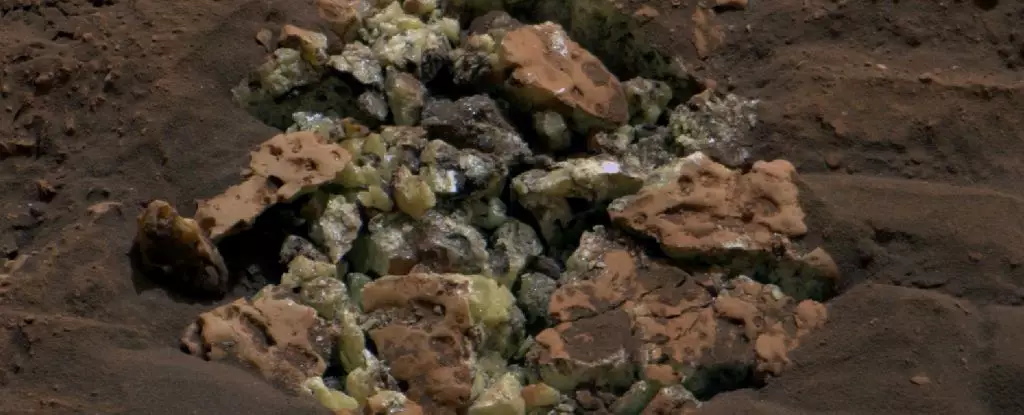A rock on Mars has just spilled a surprising yellow treasure after Curiosity accidentally cracked through its unremarkable exterior. When the rover rolled its 899-kilogram (1,982-pound) body over the rock, the rock broke open, revealing yellow crystals of elemental sulfur: brimstone. Although sulfates are fairly common on Mars, this is the first time sulfur has been found on the red planet in its pure elemental form.
Sulfates are salts that form when sulfur, usually in compound form, mixes with other minerals in water. When the water evaporates, the minerals mix and dry out, leaving the sulfates behind. These sulfate minerals can tell us a lot about Mars, such as its water history, and how it has weathered over time. Pure sulfur, on the other hand, only forms under a very narrow set of conditions, which are not known to have occurred in the region of Mars where Curiosity made its discovery.
The discovery of pure elemental sulfur on Mars raises intriguing questions about the geological history of the planet. The presence of sulfur, in its essential form for all life, hints at the possibility of past habitable conditions on Mars. While we have yet to find signs of present life on the red planet, the discovery of sulfuric rocks adds to the growing body of evidence suggesting Mars may have once been a more hospitable environment for living organisms.
Stuck here on Earth, we’re fairly limited in how we can access Mars. Curiosity’s instruments were able to analyze and identify the sulfurous rocks in the Gediz Vallis Channel, but if it hadn’t taken a route that rolled over and cracked one open, it could have been some time since we found it. The next step will be to figure out exactly how, based on what we know about Mars, that sulfur may have come to be there. That’s going to take a bit more work, possibly involving some detailed modeling of Mars’s geological evolution.
The Gediz Vallis channel is an area rich in Martian history, an ancient waterway whose rocks now bear the imprint of the ancient river that once flowed over them, billions of years ago. Curiosity has drilled a hole in one of the rocks, taking a powdered sample of its interior for chemical analysis, and is now trundling its way deeper along the channel, to see what other surprises might be waiting just around the next rock.
The discovery of elemental sulfur on Mars by Curiosity represents a significant breakthrough in our understanding of the planet’s geological and environmental history. As research continues and new data is collected, we may uncover even more mysteries hidden within the Martian landscape, shedding light on the possibility of past life on our neighboring planet.


Leave a Reply